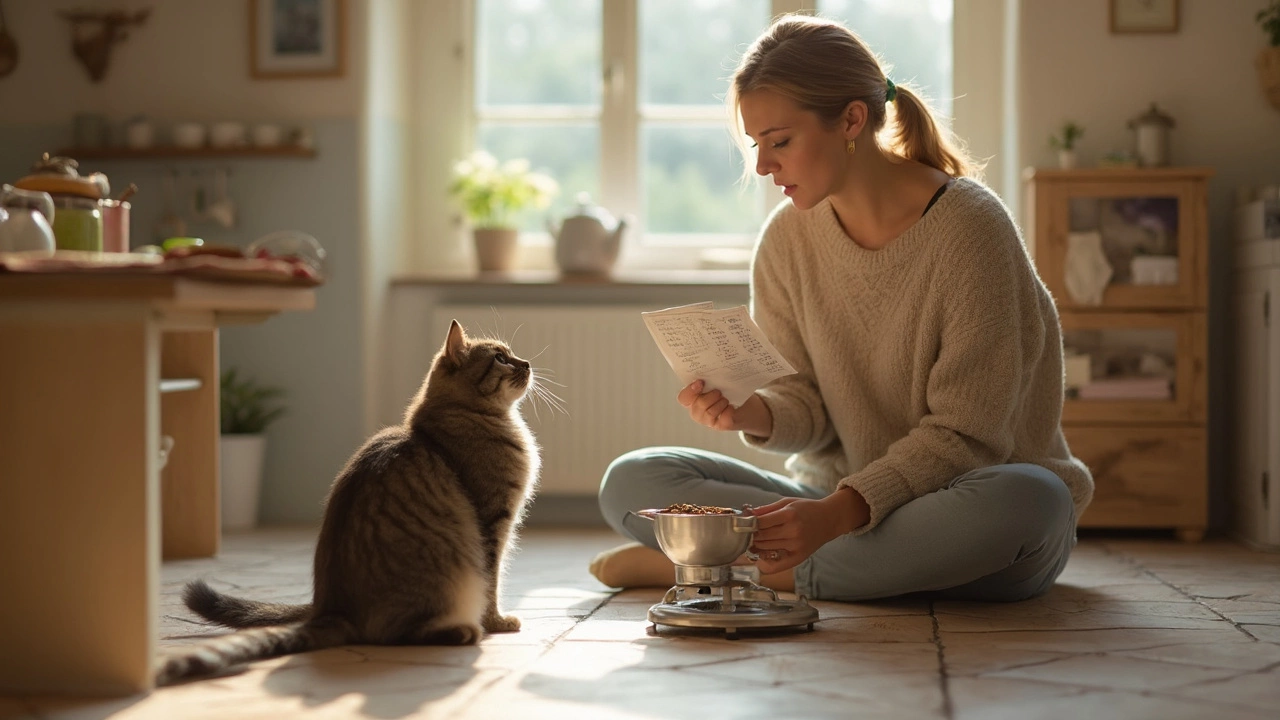Daily Cat Food Amount: Simple Guide to Feeding Your Cat Right
Figuring out how much cat food to give every day can feel like a guessing game. The good news is you don’t need a calculator or a vet’s office to get it right. A few basic steps – looking at your cat’s weight, age, activity level and the kind of food you use – will give you a solid starting point.
Step 1: Know Your Cat’s Weight and Body Condition
Start with a quick weigh‑in. If you can’t hop on a scale, use a kitchen scale for smaller cats or compare your cat to a standard reference chart. A healthy adult cat usually sits between 8 and 12 pounds, but individual needs vary. Check the body condition score: you should be able to feel (but not see) ribs, and your cat should have a waist when viewed from above. If your cat looks skinny, add a bit more food; if it’s chunky, trim the portion.
Step 2: Choose the Right Food Type
Dry kibble, wet food and mixed diets each have different calorie counts. Dry kibble typically packs around 300‑400 calories per cup, while wet food has about 70‑100 calories per 3‑ounce can. Look at the label for “kcal per serving” and use that number instead of the volume. For mixed feeding, calculate the calories from each portion and add them together.
Example: A 10‑pound cat needs roughly 200 calories a day. If you feed half dry (150 calories) and half wet (50 calories), you’d give about ½ cup of kibble plus a small 2‑ounce can of wet food.
Step 3: Adjust for Age and Activity
Kittens need more calories per pound because they’re growing fast – around 250‑300 calories per kilogram. Senior cats or indoor‑only cats burn fewer calories, so you can drop the daily amount by 10‑20%.
Active outdoor cats or cats that chase toys regularly may need a boost. Add an extra 10‑15% calories if your cat seems hungry after meals or is always on the move.
Step 4: Read the Label and Use a Feeding Calculator
Most pet food packages include a feeding chart. Treat it as a guideline, not a rule. Use the calories per cup/gram to match the calorie goal you calculated. If the chart says “½ cup for a 10‑lb cat,” but the kibble is high‑calorie, you might want to feed a little less.
Many pet stores have free online calculators. Enter your cat’s weight, activity level and the brand you use, and the tool will spit out a daily portion in grams or cups.
Common Mistakes to Avoid
1. **Treat Overload** – Treats can add 50‑100 calories per day. Count them as part of the daily total.
2. **Changing Brands Suddenly** – Different formulas have different calorie densities. Re‑calculate when you switch food.
3. **Free‑Feeding** – Leaving food out all day makes it hard to control portions, especially for indoor cats who tend to overeat.
Tips for a Smooth Feeding Routine
Measure every meal with a kitchen scale or measuring cup. Keep a feeding log for a week to see if your cat maintains a healthy weight. If you notice weight loss or gain, adjust the portion by 10% and re‑check in a few days.
Finally, give fresh water at all times. Hydration helps with digestion and can curb overeating.
With these simple steps, you’ll know exactly how much cat food to put in the bowl each day. Your cat stays healthy, you avoid waste, and feeding time becomes a stress‑free part of the day.
How Many Cans of Wet Food for a Cat a Day? Real Answers for Cat Parents
How much wet food should you actually be giving your cat each day? The answer depends on factors like your cat's age, activity level, and the size of the cans. This article breaks down how to figure out the right amount, what vets recommend, and common mistakes cat owners make with portion sizes. You'll also find practical tips for measuring and adjusting, so your cat gets exactly what they need. Get the clearest info to feel confident about your next mealtime.
